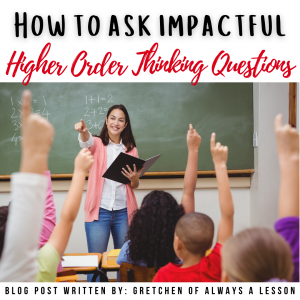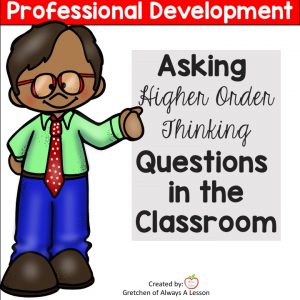How to Ask Impactful Higher Order Thinking Questions
Asking higher order thinking questions in the classroom is a simple strategy that packs a big academic punch. It’s a free tool that educators all have access to as long as they are willing to plan and prepare prior to instructional delivery.
The goal of every lesson is to drive students towards understanding. If we strip away all of the glam and technological jazz currently being used in lesson design, what is left behind is the teacher’s natural ability to share value and meaning.
- Value is the information required for students to reach mastery at their current level.
- Meaning is the teacher’s ability to make that content relevant to students.
 Students who excel academically do so because of the opportunity they encounter to digest and apply their learning. Every student is capable of interacting with higher order thinking questions at the deepest of levels. Teachers just need to make them accessible to all students.
Students who excel academically do so because of the opportunity they encounter to digest and apply their learning. Every student is capable of interacting with higher order thinking questions at the deepest of levels. Teachers just need to make them accessible to all students.
The process teachers follow to develop and deliver higher order thinking questions in the classroom is quite simple. It is one that can be repeated for every lesson on any subject each and every day.
Plan and Prepare Higher Order Thinking Questions
First, when drafting lessons plans, questioning should be sprinkled throughout instruction to gauge student understanding. The backwards design method is essential in planning such lessons because all the activities and questions asked within a lesson should take the student on a journey towards a specific outcome. Without knowing where students must end, it is impossible to align all activities and questions to get them there.
Questions should start at a basic level and become more complex as students move through the lesson. The questions can be asked orally in a student discussion or written in an assignment or on a presentation slide. Teachers can even assign specific students to questions, taking into account their zone of proximal development.
Deliver Higher Order Thinking Questions
Next, once all questions are planned, the teacher must execute them live with students during a lesson. Having questions prepared ahead of time allows the teacher to be mentally present in the moment. Teachers will have to make adjustments to the questions or the lesson in real time as student responses occur. Sometimes students will move through the questions quickly, so teachers find some of the questions unnecessary to ask. Other times, students will struggle in between questions and the teacher will have to create a question on the fly to bridge the gap. Either way, being responsive in the moment is the key to delivering high quality instruction through questioning.
It is important to note that the teacher must provide ample support for the student to arrive at the final outcome (ie. specific answer or concept). This means the students have enough context to make meaning of the question asked, access to additional information to make connections, and plenty of time to formulate a response. Although this takes up time during a lesson, it is time well spent. Students will leave the lesson with a deeper understanding of the content while also feeling successful in the classroom.
Reflect & Collect Data of Higher Order Thinking Questions
Then, great teachers reflect on their lessons, especially on the questions they ask during a lesson. it is important to collect data in the moment to aid in a reflection after the lesson is over. Teachers can simply write on their lesson plan next to the pre-developed questions, taking note of student responses, struggles, aha’s, etc. These informal data pieces will help design better higher order thinking questions for future lessons.
Once the lesson is over, the teacher can review their notes on how successful students were able to digest the new content and make meaning from it. Teachers can look for trends or outliers and even notice areas of opportunity for next time.
Revise Student Success Strategy of Higher Order Thinking Questions
Lastly, every lesson should include higher order thinking questions. It is the most effective way to develop student understanding. Therefore, teachers should continue to hone their question making and delivery methods daily to better meet student needs. As teachers better understand their content and their students, the revision process should shorten in time.
There will be students who need additional opportunities to grapple with the content where others are ready to use it as a springboard into learning something new. Differentiating questioning for these students is one way for teachers to revise their questioning strategy for future lessons. Repeat what worked and tweak what didn’t.
This four-part questioning system is one every teacher should utilize. It is easy to implement and has a tremendous impact on student learning. No fancy materials needed, just the teacher’s creativity and knowledge.
Do you need more details and practice with adding higher order thinking questions to your lessons?
Grab the mini PD here.
GO BE GREAT!
How do you implement higher order thinking questions into your classroom lessons?



 Get Edu-Tips, Freebies and grab your FREE Study Guide for Gretchen’s New Book!
Get Edu-Tips, Freebies and grab your FREE Study Guide for Gretchen’s New Book!